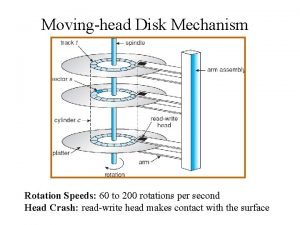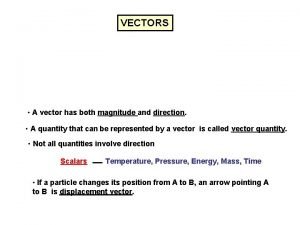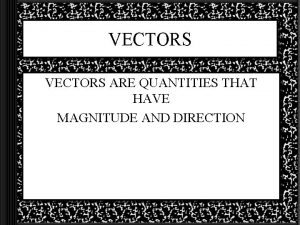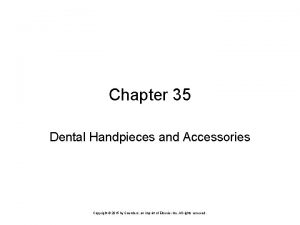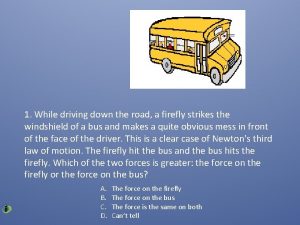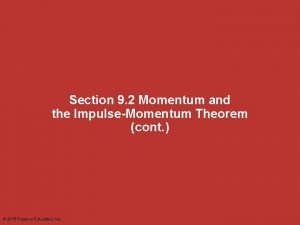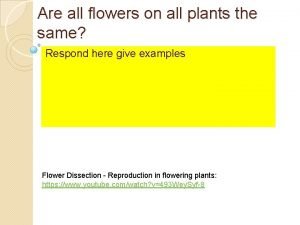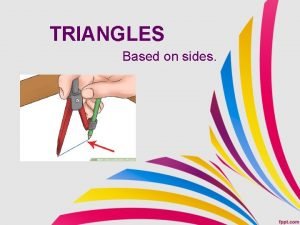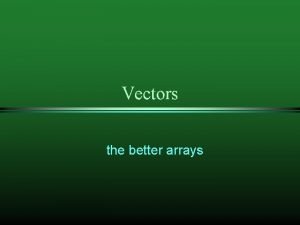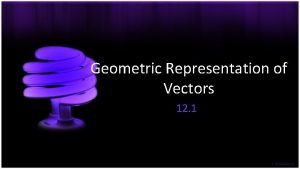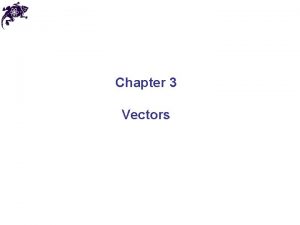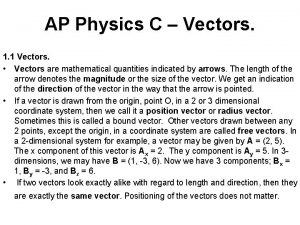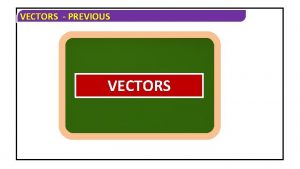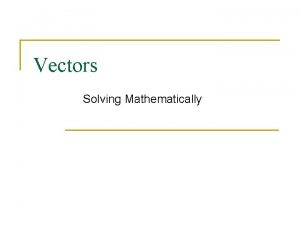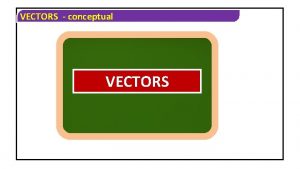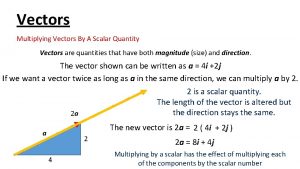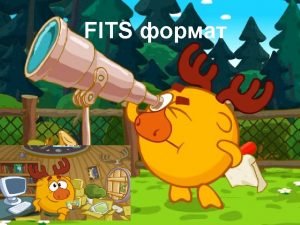Vectors Vectors All vectors have a head and






















- Slides: 22

Vectors

Vectors • All vectors have a head and a tail.

Vectors • Two Types of Quantities • Scalar – has magnitude only – Ex. Time, mass, volume, speed, distance • Vector – has both magnitude and direction – Ex. Velocity, electric, magnetic fields, force, displacement

Vectors • Vectors are named with capital letters with arrows above the letter. • Vectors are represented by arrows (ray). Drawn to scale the arrow shows the magnitude (size) and direction. • Ex 1. A = 35 km/hr east • Ex 2. B = 70 km/hr east • Ex 3. C = 20 km/hr at 350 NE

Vectors • The sum of two or more vectors is called the resultant.

Vector Addition (Head-Tail Method) • Vector quantities are added graphically by placing the tail of the second to the head of the first. • Resultant Vector (R) – the one single vector that is equal to all the vectors combined. – Resultant is drawn from tail of first to head of second vector

Vector Addition – same direction A+B=R A B B A R=A+B

Vector Addition • Example 1 : What is the resultant vector of an object if it moved 5 m east, 5 m south, 5 m west and 5 m north?

Vector Addition – Opposite direction A + (-B) = R Ex 2: A B -B A A + (-B) = R -B

Vectors • Vector Addition Triangles Ex 3: Find the resultant vector of A and B. A = 5 km/h east B = 7 km/h north R 8. 6 km/h [NE] B Use the Pythagorean Theorem to find the magnitude of the resultant vector. A 2 + B 2 = C 2 A

Check Your Understanding • Ex 4: A plane travels with a speed of 200 km/h due west. Determine the resultant velocity of the plane if it encounters a 60 km/h headwind to the south.

Right Triangles

Ex 5: How long is the base of the 2. 5 m ramp that is elevated 30 o from the ground? How high is the ramp?

Vector Resolution • Vector A has been resolved into two perpendicular components, Ax (horizontal component) and Ay (vertical component).

Vector Resolution • When resolving a vector graphically, first construct the horizontal component (Ax). Then construct the vertical component (Ay). • Using right triangle trigonometry, expressions for determining the magnitude of each component can be derived.

Horizontal Component (Ax)

Vertical Component (Ay)

Drawing Directions Ex 6: 10 units 30° E of S Ex 7: 10 units 30° S of E N N W E S

Drawing Directions Ex 8: 25 units 20° N of W Ex 9: 25 units 20° W of N N N W E S

Negative components • If you are given a negative component, it is referring to the placement on a quadrant N (-, +) (+, +) E W (-, -) (+, -) S

Negative Components • Ex 10: Draw the resultant vector with angle that is made up of an x component of 5. 5 km and a y component of -3. 5 km.

• Ex 11: You travel 650 meters east. You then travel 350 meters south, then 500 meters west, 400 meters north and finally 200 meters west. What direction is your final displacement (resultant vector)?
 Indexing head formula
Indexing head formula Flooded suction vs suction lift
Flooded suction vs suction lift Name 3 points
Name 3 points 6 vertices 12 edges
6 vertices 12 edges The attacking firm goes head-to-head with its competitor.
The attacking firm goes head-to-head with its competitor. The head of moving head disk
The head of moving head disk Parts of the head
Parts of the head What is a tonic syllable
What is a tonic syllable Quad innervation
Quad innervation Pre-head head tonic syllable tail
Pre-head head tonic syllable tail Moving head disk mechanism
Moving head disk mechanism A vector has both magnitude and direction.
A vector has both magnitude and direction. Magnitude of a vecotr
Magnitude of a vecotr The high speed handpiece uses burs
The high speed handpiece uses burs While driving down the road
While driving down the road A mosquito and a truck have a head on collision
A mosquito and a truck have a head on collision She's all states and all princes i nothing else is
She's all states and all princes i nothing else is Male flower parts
Male flower parts Mosses algae and ferns all have
Mosses algae and ferns all have For all have sinned and fallen short niv
For all have sinned and fallen short niv Dodo bird psychology
Dodo bird psychology All triangles have equal sides and angles true or false
All triangles have equal sides and angles true or false










